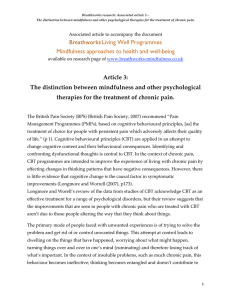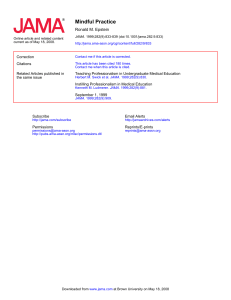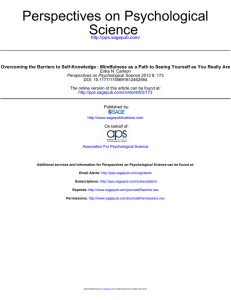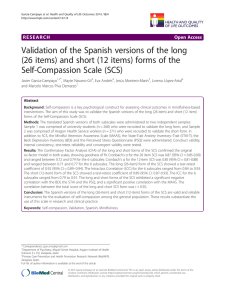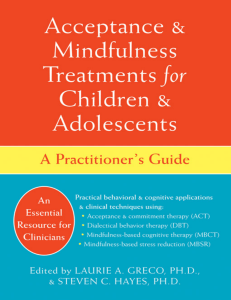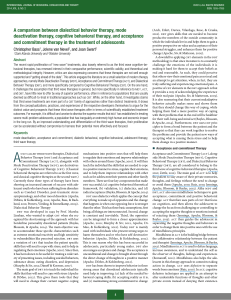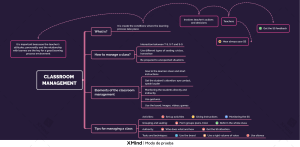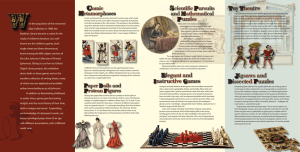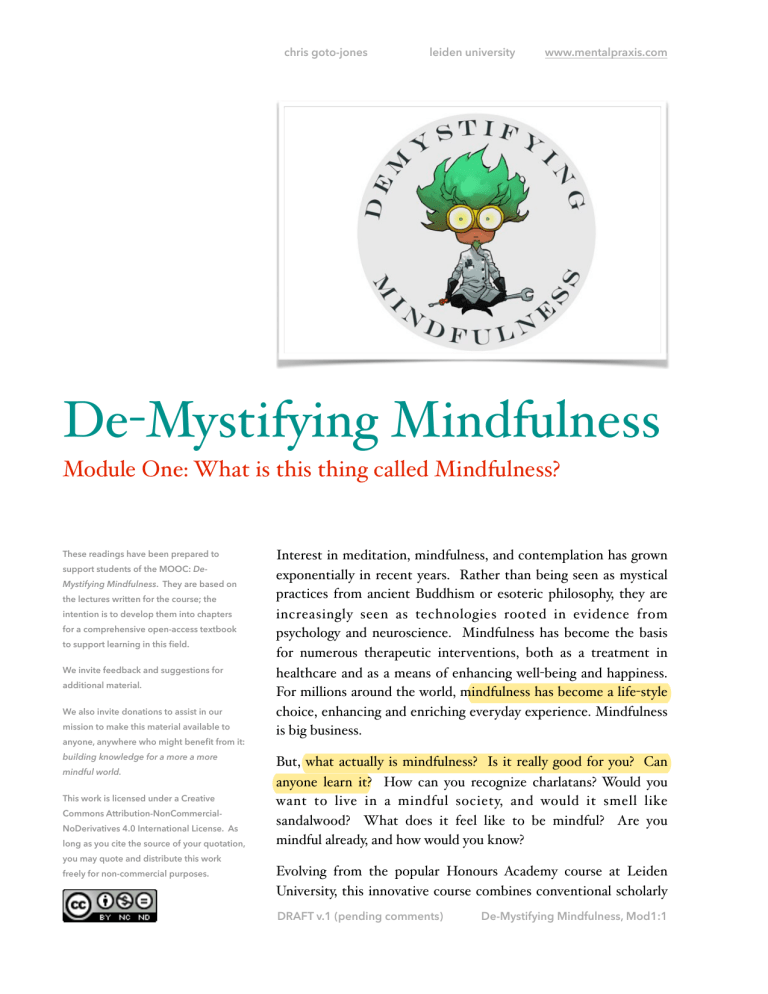
chris goto-jones leiden university www.mentalpraxis.com De-Mystifying Mindfulness Module One: What is this thing called Mindfulness? These readings have been prepared to support students of the MOOC: DeMystifying Mindfulness. They are based on the lectures written for the course; the intention is to develop them into chapters for a comprehensive open-access textbook to support learning in this field. We invite feedback and suggestions for additional material. We also invite donations to assist in our mission to make this material available to anyone, anywhere who might benefit from it: building knowledge for a more a more mindful world. This work is licensed under a Creative Commons Attribution-NonCommercialNoDerivatives 4.0 International License. As long as you cite the source of your quotation, Interest in meditation, mindfulness, and contemplation has grown exponentially in recent years. Rather than being seen as mystical practices from ancient Buddhism or esoteric philosophy, they are increasingly seen as technologies rooted in evidence from psychology and neuroscience. Mindfulness has become the basis for numerous therapeutic interventions, both as a treatment in healthcare and as a means of enhancing well-being and happiness. For millions around the world, mindfulness has become a life-style choice, enhancing and enriching everyday experience. Mindfulness is big business. But, what actually is mindfulness? Is it really good for you? Can anyone learn it? How can you recognize charlatans? Would you want to live in a mindful society, and would it smell like sandalwood? What does it feel like to be mindful? Are you mindful already, and how would you know? you may quote and distribute this work freely for non-commercial purposes. Evolving from the popular Honours Academy course at Leiden University, this innovative course combines conventional scholarly DRAFT v.1 (pending comments) De-Mystifying Mindfulness, Mod1:1 chris goto-jones leiden university www.mentalpraxis.com inquiry from multiple disciplines (ranging from psychology, through philosophy, to politics) with experiential learning (including specially designed ‘meditation labs,’ in which you’ll get chance to practice and analyze mindfulness on yourself). In the end, the course aims to provide a responsible, comprehensive, and inclusive education about (and in) mindfulness as a contemporary phenomenon. Introduction Mindfulness seems to be everywhere today. We find it in schools and universities, in hospitals and military academies; we find it in boardrooms and parliament buildings. For some it is a therapy, for others a technology, and for some it is a lifestyle choice. Tens of millions of people admit to practicing Mindfulness in North America alone … Mindfulness seems to be whatever we need it to be … it emerges into the public discourse like a mystical panacea from the Ancient East – the cure for all the ills of contemporary societies. But what actually is it? Fundamental research into Mindfulness in various disciplines in the sciences, social sciences, and humanities has grown exponentially in the last decade or so. Researchers are attempting to provide an evidence-base for what Mindfulness does to people, as well as a conceptual-base for what Mindfulness might actually be: when we say that someone is a mindful person, what are we saying about that person? When people call for a Mindful Society, do they really know what such a society would be like? Would you want to live in it? Based partially in experiential learning, this course aims to give you the theoretical and practical skills to understand and critically assess Mindfulness in its various forms for yourself. Encompassing its ancient traditions and cutting-edge science, this course seeks to de-mystify Mindfulness as a technology for life in the 21st century. Whether you’re entirely new to Mindfulness looking for clarity or an experienced practitioner looking for some more depth; whether DRAFT v.1 (pending comments) De-Mystifying Mindfulness, Mod1:2 chris goto-jones leiden university www.mentalpraxis.com you’re a Mindfulness teacher looking to broaden your understanding or a therapist looking to diversify your knowledge; no matter who you are, I hope this unusual course has something to offer you. The particular way that this course combines academic investigation in lesson 1 of each module with practical exercises in our ‘meditation labs’ in lesson 2 makes this course unique. By the time you complete these course, you will have a sound understanding of the meaning and significance of Mindfulness from various different academic, disciplinary standpoints – ranging from Psychology, through Philosophy, to Politics – AND (just as importantly) you will have experienced the equivalent of a complete 8-week Mindfulness Training course, based on the famous MBSR (mindfulness-based stress reduction) programme. This special combination of theoretical and practical learning reflects the nature of Mindfulness as a field; one of its great challenges to us today is the way that it emphasises the critical importance of our own personal experience of it as a resource for our understanding of it. So you need to be prepared to do some honest introspection during this course as part of the process of study. What you experience and feel really matters, and what you get out of this course will (at least partially) be determined by the sincerity you bring into it. Perhaps most importantly, remember to be gentle with yourself as you make your way through this adventure. It’s possible that you’ll encounter some things about yourself that you find challenging, so please allow yourself time to deal with whatever comes up. If you want to tell a member of your family or a friend that you’re taking this course, or (even better) if you want to take this together with them, that’s a great idea. You should also make use of the forums and community features of this course to connect with your fellow students; you might be surprised to see that we all encounter very similar issues and problems, and that can be reassuring in itself. Be gentle with each other too, ok? Mindfulness might strike you as a solitary pursuit, but like most journeys this one is better travelled in company. It’s my pleasure and my privilege to travel some of it with you. DRAFT v.1 (pending comments) De-Mystifying Mindfulness, Mod1:3 chris goto-jones leiden university www.mentalpraxis.com 1.1. This Thing Called Mindfulness Since you’ve made it this far (into the first session of the first module of this course), you’ve already made a series of momentous decisions and choices. Most importantly, for whatever reason, you’ve decided that you want to know a little bit more about what this thing called ‘Mindfulness’ actually is. And you’ve even decided, whether you’re fully aware of this or not, that you’d like to experiment on yourself a little in order to explore what this thing called ‘Mindfulness’ feels like for you. In fact, one of the things that’s really exciting for me is that you’re here because you want to be here. You could be doing all kinds of other things with your time, but you’re doing this. I’m guessing that you’re not being forced to do this (although maybe you are?), and you probably haven’t been prescribed this by your doctor (although maybe you have?), so there’s something about this thing called ‘Mindfulness’ that has caught your interest and made you think this might be a good way to spend some time. As it happens, taking some time to think about why we’re here is actually a pretty good place to start. The reasons why people DRAFT v.1 (pending comments) De-Mystifying Mindfulness, Mod1:4 chris goto-jones leiden university www.mentalpraxis.com become interested in Mindfulness can be fascinating, not only (but also) because it’s not immediately obvious to most people (or perhaps even to anyone) what this actually means. What is this thing called ‘Mindfulness,’ and why are you interested in it? As you might expect, I’ve asked this question of quite a few people in the past, some of them students at university, some of them colleagues at conferences, and some of them participants in Stress Reduction or Cognitive Therapy courses that I have taught in various contexts. The answers have been myriad. Indeed, the answers to this question are so interesting that entire research projects have been run in order to survey and catalogue the various reasons. You’ll get the chance to explain your reasons to your classmates (and to me) during this module, but I’d like to spend a little time today talking about some of the reasons that seem to emerge most often. Perhaps you’ll recognise some them. It’s interesting to see what we can learn about the representation of Mindfulness today from these reasons. Recent studies have asked participants on Mindfulness courses to explain their motivations for attendance. In most cases, participants are given a list of options that the researchers have pre-selected as reasons that they think should explain the motivations of participants in formal Mindfulness Interventions. In general, the results suggest that the vast majority of people who take up Mindfulness do so because they feel that it will help them to ‘reduce negative experiences’ (about 95% of people recognise this as a motivation for participation). This category also includes the aspiration to be calmer and to regulate emotion more effectively. About 30% of people hope that Mindfulness will help them to enhance their sense of ‘well-being,’ which includes aspects such as feeling happier, more fulfilled, and more self-aware, perhaps with better concentration and focus. A similar proportion of people become involved mostly because someone else tells them that it might be good for them or interest them in someway. And a minority of people (about 6%) take up DRAFT v.1 (pending comments) De-Mystifying Mindfulness, Mod1:5 chris goto-jones leiden university www.mentalpraxis.com Mindfulness because they associate it with religious or spiritual cultivation, and with Buddhism in particular. These general responses by people taking formally approved and accredited Mindfulness courses like Mindfulness-Based Stress Reduction (MBSR) or Mindfulness-based Cognitive Therapy (MBCT) do capture quite a few of the most important ways that Mindfulness is represented today. Perhaps you already have a sense of Mindfulness as a technique or technology that might help you to deal with (or cope with) various negative aspects of your life, and might also help you to enhance various positive aspects of your life? And, given how pervasive and popular Mindfulness has become in recent years, it’s quite likely that you know people who have told you about their experiences of Mindfulness in these terms. One result from these formal studies that surprises me is the relatively small proportion of people who apparently come to Mindfulness for reasons associated with spirituality or religion. Given the amount of Mindfulness taught in Buddhist contexts (including so-called ‘secular Buddhist’ contexts), including Vipassana or Insight Meditation Centres, this is especially surprising. There are lots of possible reasons for this, which include (for instance) the fact that data like this is usually drawn from populations who are attending formal 8-week secular Mindfulness programmes (of the kind we’ll discuss in module 2 of this course), so the population is pre-selected based on their instrumental motivations. That is, people learning Buddhist Mindfulness are effectively excluded from the data. Another possible reason is the vagueness of the terms ‘spiritual and religious,’ which can mean all kinds of things (positively and negatively) to different people, and it’s not always clear how (or whether) these differ from other concepts (like ‘self-cultivation’ for instance) which might in turn seem very similar to something like the cultivation of ‘well-being’ and so on. Something that’s clear from my own experience is that this last question (of spirituality) is quite often unresolved in the minds Mindfulness practitioners (and everyone else). And when I say that it is ‘unresolved’ I mean something like this: some people come to Mindfulness precisely because they have been convinced that it has nothing to do with spirituality, but at the same time DRAFT v.1 (pending comments) De-Mystifying Mindfulness, Mod1:6 chris goto-jones leiden university www.mentalpraxis.com fearing that it might have something to do with spirituality; for these people, the idea of spirituality signifies something like the absence of scientific reason. So while their motivation is not about spirituality per se, spirituality is one of their unresolved concerns about Mindfulness. Their fear is that contemporary Mindfulness is somehow in denial about its relationship with spirituality; that it both isn’t and is a spiritual discipline at the same time. In fact, this kind of lack of resolution is also present in quite a lot of the scholarship about Mindfulness, which often navigates uncertainly and nervously around questions of Buddhism and Buddhist psychology, as though talking too much about (what is sometimes called) ‘the B word’ might undermine the scientific credibility of the work being done. Underlying this view is a deepseated cultural scepticism in Western societies that forms of knowledge that have originated anywhere other than Europe are unscientific and ultimately muddle-headed. It is at least partially because of this that practitioners and scholars remain slightly anxious about what kind of knowledge we’re interested in when we’re interested in Mindfulness. But this is also one of the reasons why Mindfulness is so cutting-edge and exciting – it relies on and builds bridges between different traditions of thinking about (and experimenting on) human consciousness. Today, Mindfulness emerges as a real child of global modernity, bringing together knowledge, theory, and method from multiple disciplines and regions from around the world. In other words, when we talk about ‘spirituality’ in the context of modern Mindfulness, we need not be talking about New Ageism or the Hippie Movement (although we might be talking about the scientist’s fear of association with these). We need not be talking about something that opposes scientific method or reason. Instead, we could be talking about the idea that Mindfulness is a kind of ‘consciousness discipline’ that exists at the intersection of myriad forms of knowledge and inquiry, rooted in the creativity and openness of contemporary science. In other words, our anxiety about the tension between scientific rationality and spirituality is one of the ways in which Mindfulness remains rather mysterious and provocative today. Even if you’re not someone who worries about this personally, the chances are DRAFT v.1 (pending comments) De-Mystifying Mindfulness, Mod1:7 chris goto-jones leiden university www.mentalpraxis.com good that you live in a society in which this is a general concern of modernity. It might be worth pausing at this point to ask yourself about your motivation for studying this course. In particular, why not check in with yourself right now, before we really get started, and see how you feel about the possibilities that this journey might be an entirely scientific one, or that it might (perhaps also) involve elements of a spiritual journey (howsoever we might define that). It’s also possible that these amount to the same thing. How do you feel about that? In the rest of this first module, then, we’re going to take a brief look at some sketches of what Mindfulness means to different people. We’re going to do this in the form of exploring three big archetypes or ideal-types that represent popular preconceptions about Mindfulness, including some fears and prejudices and romances about it. And then, in the rest of this course, we’re going to slowly and systematically work out which elements of these preconceptions stand up to scrutiny and which are simply misconceptions or fantasies. We’re going to look at the figures of the monk, the ninja, and the zombie. Today, we’ve already considered some of the preconceptions of the scientist – our fourth model. These sketches, which are sometimes ridiculous, also provide us with a way into the big question: what the heck is this thing called Mindfulness? At the very least, these preconceptions reveal that there are a number of different (and sometimes competing) understandings of (and associations with) Mindfulness today, which can leave us confused or even mystified about what it actually is, or even whether it is actually anything at all. So, having explored some of this terrain, the rest of the course aims to map-out and demystify the landscape, explaining what this ‘Mindfulness thing’ really looks like today, and how we can (sensibly) talk about it in different ways and senses. DRAFT v.1 (pending comments) De-Mystifying Mindfulness, Mod1:8 chris goto-jones leiden university www.mentalpraxis.com 1.2. Preconception: Enlightenment In our last session, we explored some of the reasons why people (like you and me) might become interested in Mindfulness. In particular, we considered the popular contemporary image of Mindfulness as a scientific technique or technology that is deployed in secular contexts and often for therapeutic purposes. And we associated this approach with the image of the scientist. In today’s session, as part of a little series of talks exploring different preconceptions about Mindfulness (and what it might mean to be a ‘Mindful person’) we’re going to take some time to investigate one of the most popular and pervasive associations with Mindfulness – the image of the Buddhist monk. As we discussed in the last session, the purpose of these little sketches is really to reveal some popular impressions about Mindfulness before we start looking more seriously at where these impressions might have come from and what kind of value they have. One of the things that’s fascinating about these images is that, while they often contain a number of misperceptions, mistakes, and fabrications, they are usually based on (or at least touch) some genuine insights and associations. Hence, exploring these images is quite a good way to orient ourselves at the start of DRAFT v.1 (pending comments) De-Mystifying Mindfulness, Mod1:9 chris goto-jones leiden university www.mentalpraxis.com a course like this one: we can learn a lot about what kind of assumptions we’re bringing with us, and thus what kind of work we need to do while we’re here. To some extent, the image of the Buddhist monk represents a classical aspirational image of spiritual development. It sits somewhere between the ‘sage’ and the ‘saint’ as, what Robert Neville calls, a ‘spiritual model.’ It expresses our ideal of Enlightenment and our emancipation from the confines of everyday knowledge and wisdom. In other words, while expertise and understanding in everyday life might make us good at our jobs or successful at exams or able to solve concrete practical problems, the wisdom of the sage seems more attuned to dealing with the grandest questions of meaning in life, the universe, and everything. So, it is not technical knowledge, but rather it emerges from patience, experience, and attunement with the world. Indeed, the figure of the sage often appears to lack basic factual knowledge and expertise about everyday life – sages can be idiots; the wisdom of the sage is usually represented as somehow ‘seeing through’ the everyday to the profound, as though the everyday world with which we’re so o b s e s s e d a n d i n w h i c h we co n s t a n t l y s t r i v e f o r m o r e accomplishments, more possessions, more money etc. is itself somehow debased or sullied or even illusionary. Hence, the sage seems to embody an alternative moral order, in which worldly (material) success is not only seen as trivial, but it is also seen as essentially vacuous. It’s not only that we spend our time and energy on things that have little value; it’s also that we should (with moral force) … we should spend our time and energy on more elevated pursuits instead. What does this mean in practice? In practice, it means something like this: The model of the sage teaches us that … instead of spending our time worrying about passing an exam, impressing someone at a job interview, or earning enough money for a new iPhone, we should instead spend our time sitting in meditation on the nature of our self and the present moment. DRAFT v.1 (pending comments) De-Mystifying Mindfulness, Mod1:10 chris goto-jones leiden university www.mentalpraxis.com Instead of fretting about mistakes we made in the past, feeling unhappy about our weight or embarrassed about our clothes, or being angry about the injustice that an undeserving colleague got the promotion that we wanted at work, we should instead spend our time appreciating the beautiful patterns being made by the clouds in the sky, or the delicate feeling of rain on our skin, or the wonderful feeling of warmth that the sun leaves on our face. This kind of sagacity involves a self-conscious and deliberate reorientation of our relationship with life itself. Because it involves moving against the prevailing norms and values of commercial societies, it requires of us tremendous amounts of self-discipline, practice, and cultivation. The sage is committed and dedicated; devoted. Which also gives him/her an aura of purity and sacredness; we revere the sage precisely because he/she is better than us – we could be like them if we had the necessary discipline and awareness, but we don’t (or we choose not to), so we’re not. As this course develops, we see how this classical ideal of the sage shares a number of features with environment of Mindfulness today; and for some people the association between the cultivation of Mindfulness and the cultivation of wisdom or enlightenment is strong. Indeed, as we’ll see in module 3, these associations are basic to the concept of Mindfulness in many traditions of philosophy around the world. One of the most immediate connections that many people make between Mindfulness and the ‘spiritual hero’ of the sage is mediated by the figure of the Buddhist Monk. As we’ve already seen in the last session, and as we’ll see over and over again throughout this course, it is well-known that there is a sense (actually quite a complicated sense) in which Mindfulness emerges from Buddhist traditions, and hence, for some, its practice is always and already associated with the image of the monk. From these associations, we can recognise the following three popular preconceptions about Mindfulness today: Mindfulness is somehow Asian or ‘Oriental,’ and so it’s not clear how it fits into ‘Western’ societies and cultures. We might identify this preconception as the ‘Problem of Orientalism,’ which can work to both attract and repel people with different ideological dispositions, as we’ll see later. DRAFT v.1 (pending comments) De-Mystifying Mindfulness, Mod1:11 chris goto-jones leiden university www.mentalpraxis.com The practice of Mindfulness is essentially (at root, deep down) a religious practice, no matter what anyone tells you to the contrary. It’s purpose is only therapeutic to the extent that the Buddha was the original therapist, and his teachings emancipate us from suffering by liberating us from ourselves. We might identify this preconception as the ‘Problem of Secularism,’ which (like the problem of Orientalism) acts to attract some and repel other people, as we’ll see later. This ‘problem’ can make people slightly ner vous about the kind of ethical commitment expected of those who decide to take up the practice of Mindfulness. Although it is also associated with a surprisingly common assertion these days, that Buddhism is not really a religion at all … To practice Mindfulness properly, you have to sit in a particular way (probably the lotus position), you have to hold your hands into a complicated pattern (or mudra), you have to chant (mantra), burn incense, and shave off your hair etc. And ideally, you have to sit on the top of mountain, next to a lake, in a temple, or under a tree. We might identify this preconception as the ‘Problem of Trappings,’ which is closely related to both the problems of Orientalism and Secularism. And again, this preconception can attract or repel potential practitioners, depending on their ideological standpoint. As we’ll see later, these ‘trappings’ can be helpful for some people who find them helpful, but they are not basic to the practice of Mindfulness and they can also make practitioners anxious about what it means to be ‘doing it right’ when they practice. So, I hope this little sketch of the monk as a kind of spiritual hero has helped us to recognise some popular preconceptions and assumptions about Mindfulness today. Our friend the monk will stick around with us, to help out during the rest of this course. In the next session, we’ll turn our attention to a different kind of spiritual model – the warrior … and, in our case, the ninja. DRAFT v.1 (pending comments) De-Mystifying Mindfulness, Mod1:12 chris goto-jones leiden university www.mentalpraxis.com 1.3. Preconception: Martial Magic Following on from the models of the Scientist and the Monk, in this session we’re going to consider the example of the warrior as aspirational icon in modern societies, and especially how the features of this classical ideal might be associated with Mindfulness today. In fact, quite a few people – especially younger people – become interested in Mindfulness because of a perceived connection between it and the Martial Arts: the character of the spirit-warrior or warrior-monk has been common in literature and popular culture throughout history in various parts of the world. For recent generations, this model is perhaps best exemplified by the Jedi-knight (sitting in meditation, quieting his mind to listen to the living Force around him), or by our friend … the mythical ninja. In many cultures, the warrior as ‘spiritual hero’ represents an ideal of psychic integrity. Rather than being a thoughtless or arbitrary agent of violence, this warrior represents the human aspiration towards disciplined control over our attention, awareness, and emotional state. Indeed, the warrior emerges as the most extreme and accomplished version of this ideal, since his/her psychic integrity is tested (and actually cultivated) in extremis – in the face of danger, violence, and death. In the end, part of the warrior’s integrity resides in his/her abandonment of their sense of self – their actions must be in the DRAFT v.1 (pending comments) De-Mystifying Mindfulness, Mod1:13 chris goto-jones leiden university www.mentalpraxis.com service of a greater good, not the result of personal desires, instrumental reason, or ego-driven volition. Their disciplined selfcontrol and self-deprivation become a radical form of selflessness, which ultimately resembles a spiritual accomplishment. Hence, somewhat like the monk in our last session, the ninja seems to embody an alternative moral order, in which our attachments to material goods and even to our emotional states themselves are seen as essentially flawed, decadent, and degenerate. When we live our lives caught up in the rat-race of everydayness, chasing possessions and indulging our emotions, we are simply failing to act with adequate discipline, attention, and awareness – we are behaving in a manner unsuited to our basic integrity. Hence, the warrior represents our aspiration to be better people, by being less concerned with objects and desires, and more concerned with cultivating a disciplined sense of selflessness. So, what does this mean in practice? Well, in practice it means something like this: the model of the warrior teaches us that … instead of spending our time indulging our whims and desires for pleasure and luxury, which soften our resolve and undermine our integrity, we should instead spend our time and energy cultivating our discipline by deliberately depriving ourselves of those things that we want. Instead of lounging on the couch, vegetating in front of the television, or dozing on the beach, we should instead spend our time cultivating our minds and bodies through rigorous programmes of meditation, yoga, and the martial arts, such that we approach something like mastery of ourselves. Like the monk, then, the ninja here is a model of devotion and commitment in a society that is characterised by indulgence, weakness of will, frivolity and fickleness. The ideal of the warrior calls upon us to reflect on our mortality and on our lives as a constant process of confronting and overcoming death: the warrior ideal asserts that we would be better people if we were able constantly to hold in our attention the possibility that this moment (right now) might be our very last moment of life. Hence, the discipline of the ninja manifests not only in tremendous DRAFT v.1 (pending comments) De-Mystifying Mindfulness, Mod1:14 chris goto-jones leiden university www.mentalpraxis.com physical skill and competence, not only in selflessness of conduct, but also in the ability to maintain a radically present-moment awareness. Put together, these features make the ninja calm and tranquil in the face of suffering, adversity, and danger, even in the face of death itself. As this course develops, we will see how this classical ideal of the warrior shares a number of important features with the environment of Mindfulness today; and for some people the association between the cultivation of Mindfulness and the cultivation of discipline and integrity in the present moment is strong. Indeed, as we’ll see in modules 3 and 4, these associations are not limited to the application of Mindfulness in military contexts (although they’re also found there), but are rather general. In fact, we might recognise at least the following three popular preconceptions about Mindfulness today, which seem to emerge from this model: The practice of Mindfulness is austere, disciplined, and unforgiving, requiring practitioners to hold perfect (and sometimes tortuous) postures for long periods until it hurts (and then to carry on after it hurts as well). People who enjoy Mindfulness are simply not doing it right. We might identify this preconception as the ‘Problem of Discipline,’ which can work to attract or repel people with different aesthetic tastes and dispositions, and which seriously challenges the permissive and compassionate tone of much Mindfulness training today. The practice of Mindfulness involves the cultivation of esoteric powers, such as levitation or super-human fighting abilities like energy balls or Force-powers. Mindfulness makes us spontaneously aware of what’s going on in our surroundings, and thus makes us able to respond instantaneously to anything that happens. Hence, practicing Mindfulness also means practicing physical disciplines such as yoga, qi-gong, or martial arts. We might identify this preconception as the ‘Problem of Magic,’ which can work to attract certain people (who will end up being very disappointed by Mindfulness training) and to scare off other DRAFT v.1 (pending comments) De-Mystifying Mindfulness, Mod1:15 chris goto-jones leiden university www.mentalpraxis.com people (who don’t want to be associated with esoteric practices, even though they have (almost) no place in modern Mindfulness). The contagious power of this preconception can be seen in all kinds of places, but perhaps most famously in the ideas of the US Army’s infamous ‘First Earth Battalion’ in the 1970s. The practice of Mindfulness is centrally concerned with the death of the self, not only in the sense that it cultivates a distinctly present-moment focus (and hence causes the falling away of emotional investments and motivations), but also in the sense that it confronts us with mortality itself by preparing us for encounters with death. We might identify this preconception as the ‘Problem of the Self,’ which is closely related to issues we’ll discuss in the next session about the fear of a type of intimacy between Mindfulness and Mindlessness. It’s also related to the ‘Problem of Secularism’ that we explored in the previous session. One the distinctions of the Problem of the Self here, though, is the way that it moves our discourse away from therapeutic issues altogether, and suggests that Mindfulness is really a form of existential pursuit. As we’ll see later, this is a pervasive anxiety in the field. So, I hope this little sketch of the ninja as a spiritual hero has helped us to recognise some popular preconceptions and assumptions about Mindfulness today. Like the monk from our last session, our friend the ninja will stick around with us, to help out during the rest of this course. In our next session, though, we’re going to turn our attention to a different kind of spiritual model – this time a model of a nightmare rather than a dream; we’re going to look at the case of the zombie. DRAFT v.1 (pending comments) De-Mystifying Mindfulness, Mod1:16 chris goto-jones leiden university www.mentalpraxis.com 1.4. Preconception: Mindlessness In the last few sessions, we’ve spent quite some time exploring some of the ways in which Mindfulness is represented in popular culture and in contemporary societies. In particular, we’ve considered the images of the scientist, the monk, and then the ninja as archetypes that illustrate some of the associations and preconceptions that are prevalent around Mindfulness today. In each case, we’ve seen how the image corresponds to a specific model of aspiration and spiritual development; rather than being (or perhaps as well as being) slightly ridiculous, we have seen that each of these models provides us with some insight into how Mindfulness is perceived and motivated, and also what it might actually be in practice. In today’s session, we’re going to consider briefly the reverse of these (ostensibly) positive representations. In other words, when we talk about Mindfulness today, what are the negative preconceptions or the images of nightmares that occupy people’s thoughts? As it happens, some of the introductory literature of Mindfulness today makes explicit reference to a number of fears in order to reassure new practitioners that their preconceptions are groundless. One of the most famous of these is probably this passage from Jon Kabat-Zinn, who says: ‘When we speak of DRAFT v.1 (pending comments) De-Mystifying Mindfulness, Mod1:17 chris goto-jones leiden university www.mentalpraxis.com meditation, it is important for you to know that this is not some weird cryptic activity, as our popular culture might have it. It does not involve becoming some kind of zombie …’ (Kabat-Zinn, Wherever You Go 1994, 9) In fact, the image of the zombie is really quite helpful for us in our quest to understand what frightens people about Mindfulness – and we’ll be returning to it quite frequently in the rest of this course, especially when we talk about politics later on. Of course, the zombie is an icon of horror for all kinds of reasons today. Most importantly, perhaps, it is the image of what happens to a human being when he/she has lost his sense of self, or perhaps lost his self entirely. The zombie is what humans look like after their self or their ago or their personality has died (and, coincidentally, also what they look like after they have literally died). The zombie is our nightmare of what the post-human condition might look like. What’s more, we think of zombies as forms of mindless automata, slowly going through the movements and motions of life but without meaningful emotional engagement and without the application of discriminatory or instrumental reason. Because of this, zombies emerge as a type of slave, unable to act for their own benefit (indeed, unable even to conceive of what this might entail). They are a vision of a human body that has shed its humanity, leaving only a kind of ‘zero-level’ of unreflective, craving non-life. Hence, when we talk about Mindfulness and the fear of zombies, what we’re really talking about is something like the following three preconceptions about Mindfulness: The practice of Mindfulness is really about learning to dissemble and eradicate our ego, our personality, and ultimately our sense of self itself. It involves shedding our emotional attachments and our volitional imperatives, leaving us as the equivalent of empty husks or shells of bare consciousness. We might identify this preconception as a negative variation on the ‘Problem of the Self ’ that we also saw in the last sessions, where the idea of shedding aspects of our selves was seen as a form of liberation or self-transformation. Here, it resembles a kind of retardation or even death. DRAFT v.1 (pending comments) De-Mystifying Mindfulness, Mod1:18 chris goto-jones leiden university www.mentalpraxis.com The practice of Mindfulness is basically about trying not to think about anything in any way recognisable as thinking. It involves abandoning rationality, instrumental reason, and critical judgement. It’s about sitting in a space of vacuity (or void) in which we can no longer think properly or pro-actively, but instead we merely respond instinctively to whatever happens around us. Instead of acting positively in a driven way towards a goal or accomplishment, Mindfulness encourages us to stagger around slowly and aimlessly, simply feeling the direct and unprocessed sensations of our body as we move. We might identify this preconception as the ‘Problem of Irrationality,’ in which stepping outside goal-oriented and discrepancy-based thinking is not seen as a means of emancipation from the iron cage of reason (as it might have been in the last two sessions), but is instead seen as the collapse of thinking per se. The practice of Mindfulness is really about internalizing a repressive ideological vision of the meaning of being human, which prevents us from resisting authority or challenging the status quo. In other words, Mindfulness is about reducing ourselves to a kind of ‘zero-level’ of consciousness because it confuses the treatment or eradication of stress for the eradication of our humanity itself. Being human means that we are stressed about the need to change things; so, being without stress means that we are no longer fully human. We might identify this preconception as the ‘Problem of Humanity,’ since it reveals a fundamental concern about the kinds of lives that human beings are supposed to lead and the kind of lives that we are not supposed to lead – lives that are not appropriate to human dignity. Rather than representing an enhancement or a purification of human life, as we saw in the last sessions, the fear here is that Mindfulness is a form of humiliation. These kinds of fears about Mindfulness have a long pedigree through history, as we’ll see later in this course. In general, as we’ll see, commentators are keen to see them as indications of our fears about ourselves, rather than fears about Mindfulness per se. However, something that does emerge very clearly from this DRAFT v.1 (pending comments) De-Mystifying Mindfulness, Mod1:19 chris goto-jones leiden university www.mentalpraxis.com nightmarish model of the zombie is the common and pervasive idea that Mindfulness is a powerfully transformative practice. Indeed, to some extent, the zombie might be seen as representing the opposite evaluation of some of the same transformations identified in the models of the monk and the ninja, where they were positively evaluated. In any case, our friend the zombie will stick around with us to help out during the rest of this course. Before we wrap up this first module with a summary in the next session, I should also introduce our final Mindfulness Model – the hippie, who emerges as a similar (but much less extreme) figure to the zombie. One of the fascinating aspects of the Hippie as a model is that there is much less consensus about whether he/she is a positive or a negative model, in terms of their association with Mindfulness. For instance, the hippie is often represented as a counter-cultural radical, embodying political protest against the rampant materialism and ambition of capitalist society through practices of self-transformation, AND he/she is represented as having dropped out of human society by giving up on instrumental reason and conventional conceptions of selfhood. The hippie is a model of coping with modernity and of failing to cope with it. The hippie is both the dream (for some) and the nightmare (for others). When it comes to Mindfulness then, the model of the hippie expresses all kinds of (often conflicting) preconceptions about the psychological and social significance of the practices involved. So, our friend the hippie will join us throughout the rest of this course to help out as we navigate all these issues. DRAFT v.1 (pending comments) De-Mystifying Mindfulness, Mod1:20 chris goto-jones leiden university www.mentalpraxis.com 1.5. Summary So, you’ve made it through to the end of the first module of this course, and I’m wondering how you’re doing. To some extent, this module has been atypical, at least in so far as the material this lesson has focussed more than usual on self-reflection for you. Instead of working our way through scientific research on the neurophysiological correlates of Mindfulness meditation (which we’ll do in the next module), or the conceptual underpinnings of Mindfulness in different philosophical traditions (which we’ll do in module 3), or the ideological and political significance of Mindfulness in contemporary societies (which we’ll do in module 4), this module has required you reflect on your own motivations and preconceptions about Mindfulness. In other words, at least in a particular sense, you have been the subject material for this first module, and I hope you’ve managed to give yourself some space to enquire into yourself. It’s not always an easy thing to do, and it goes against nearly everything we’re usually told at school and in university, where the idea that knowledge might be importantly dependent upon the knower is generally frowned upon. In today’s educational environments, in general, we quest relentlessly for a form of objective, instrumental knowledge on which we have no effect other than to bring it into our possession, so it’s not always easy or comfortable for us to DRAFT v.1 (pending comments) De-Mystifying Mindfulness, Mod1:21 chris goto-jones leiden university www.mentalpraxis.com engage with a more subjective, formative sense of knowledge, which not only relates to us but also relies on us. In some ways, though, despite its slightly unusual focus on our own motivations, preconceptions, and reflections, this first module provides a model for the rest of this course. As a field, Mindfulness requires us to be open to experiential learning, and to take ourselves seriously as our first, best, and most reliable source of such learning. Indeed, this is one of the primary motivations for including the Meditation Labs in this course, which you’re also experiencing for the first time in lesson two of this module – they will appear in lesson two of all subsequent modules too. And I’m really interest to know how you get on with the meditation practices in this module, especially in the context of the reflections we’ve been working on in the rest of the module. I’m looking forward to seeing your posts about all this; your insights are not only valuable to you (and me) but also to your colleagues and friends on this course. When it comes to our motivations and preconceptions about Mindfulness, the real point of this first module has been to reveal the breadth and richness of the various different understandings of it. It is one of the most immediately troubling things about Mindfulness (at least when we first approach it) that there is so much ambiguity, doubt, and uncertainty about what it really means. And there are so many voices and movements in contemporary societies attempting to claim it or appropriate it or control it as a concept, a practice, and a movement. For some of us, this can make approaching this field confusing and (given its apparently transformative nature) it can also make us feel vulnerable in the face of such confusion, as though we are exposing ourselves to something potentially toxic or subversive. However, in this module we’ve sought to embrace the diversity of this field as part of its richness and potential. We’ve explored a number of popular conceptions, preconceptions, and misconceptions about Mindfulness today, accepting that they form part of the landscape. By mapping out some of these ideas using some archetypes and models (like our new friends the scientist, the monk, the ninja, the zombie, and the hippie) we have gained a pretty good sense of how flexible and elastic ‘this thing called Mindfulness’ is today. DRAFT v.1 (pending comments) De-Mystifying Mindfulness, Mod1:22 chris goto-jones leiden university www.mentalpraxis.com One of the things that emerges from all this material is the need to be a little sensitive to and accommodating of the range of claims made in the name of Mindfulness today. Rather than taking a hard-line from the start and claiming that everyone else is wrong about Mindfulness and that only I (or only you) really know what it is, one of the things we learn from all this is that Mindfulness today has developed as a social and cultural construct. It is constantly assembling and reassembling itself in response to social changes and needs, as researchers, practitioners, and businesses discover new possibilities for its development (and perhaps also for its monetization). This idea of a flexible, evolving, and always contemporary ‘construct Mindfulness’ will be essential to the work we do in the rest of this course. We’ve seen that the landscape of construct Mindfulness involves (amongst other things), inquiry and insight into Orientalism, Secularism, and Materialism; Discipline, Magic, and Selfhood; Intuition, Rationality, and Humanity. It seems to be characterized by an emphasis on self-transformation through practice (of various kinds), where such practices focus on the cultivation of a particular form of present-focussed awareness and attention, and where the transformation in question might be towards enhanced well-being, diminished suffering, better psychological adaptation to the world, or even simply towards being better in the grandest sense. We also learn from this module that this complicated culture of construct Mindfulness today variously relies upon different historical traditions and associations, each of which make some kind of claim about their legitimate ownership of the concept and practice of Mindfulness. That is, we can see the possibility of a politics of knowledge in which individuals and traditions dispute the meaning of ‘real Mindfulness’ or ‘original Mindfulness.’ This idea of ‘traditions of Mindfulness’ will be a strong feature of the work we do in the rest of this course, as we explore how different sense of this complicated term interact historically, conceptually, and practically. For instance, in the next module we’ll consider how Mindfulness relates to an instrumentalized, clinical Mindfulness? Given that they are clearly not exactly things, can we really say that only one of them DRAFT v.1 (pending comments) Buddhist sense of the same is really De-Mystifying Mindfulness, Mod1:23 chris goto-jones leiden university www.mentalpraxis.com Mindfulness? Come to that, why would we want to say such a thing? In general, this course rests upon the belief that unearthing all these different standpoints, perspectives, instruments, practices, and traditions is the best (and perhaps only) way to clarify what this thing called Mindfulness actually is. This is the demystification of Mindfulness. And yet, this process makes no claims to (even attempting to) establish a single, exclusive meaning for the term – rather, we are interested in seeing the landscape of possibilities. And then, really importantly, I hope that you will make some choices for yourself about where (if anywhere) in this landscape you’d like to live. As we’ve seen already (and will see again over and over), one of the basic qualities of Mindfulness that is retained in nearly every examination of it – we might think of it as the ground on which the landscape has been built – is its dependence upon the experiences and intentionality of its practitioners. So, what you think, feel, and experience while you’re investigating Mindfulness really matters for you – in some ways you’re forging your own contribution to this landscape as we go along. If you decide that Mindfulness is going to be part of your life, you need to know that your Mindfulness is your own, and that you have discovered it in a Mindful way that embodies your own integrity. This means (amongst other things) that I’m not going to tell you what Mindfulness ‘really is’ (indeed, it means that I can’t), although I am going to do my best to guide you through the relevant material and to help you with some of the formative experiences. I’m also going to explain some things about myself and my experience of Mindfulness, not because your experience needs to be the same as mine, but simply because it might be helpful for you to know that I’m sharing this adventure with you. DRAFT v.1 (pending comments) De-Mystifying Mindfulness, Mod1:24 chris goto-jones leiden university www.mentalpraxis.com These readings have been prepared to support students of the Coursera MOOC: De-Mystifying Mindfulness. They are based on the lectures written for the course; the intention is to develop them into chapters for a comprehensive open-access textbook to support learning in this field. The images were conceptualized by Chris Goto-Jones with art by Siku, copyright on the images is reserved, mentalpraxis.com (2016). We invite feedback and suggestions for additional material for these readings. We also invite donations to assist in our mission to make this material available to anyone, anywhere who might benefit from it: building knowledge for a more a more mindful world. This work is licensed under a Creative Commons Attribution-NonCommercial-NoDerivatives 4.0 International License. As long as you cite the source of your quotation, you may quote and distribute this work freely for non-commercial purposes. DRAFT v.1 (pending comments) De-Mystifying Mindfulness, Mod1:25 chris goto-jones leiden university DRAFT v.1 (pending comments) www.mentalpraxis.com De-Mystifying Mindfulness, Mod1:26
